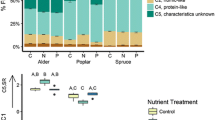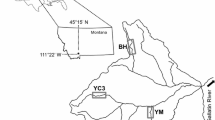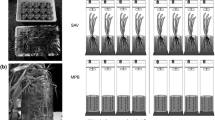Abstract
Hydrologic flowpaths might propagate biogeochemical signals among connected ecosystems or alter and dampen signals because of reactions or retention occurring during transport. In the Arctic, experimentally warmed terrestrial tundra releases inorganic nitrogen (N), but the fate of this newly released N remains unclear. Nitrogen could be passively transported downslope in flowing water, or retained when flowpaths intercept N-limited ecosystems. We applied nutrient spiraling theory to simultaneously measure reaction and transport of ammonium (NH4+) and phosphate (PO43−), nutrients limiting primary productivity in Arctic ecosystems. Pulse fertilization experiments were focused on flowpaths known as water tracks that hydrologically connect soils to receiving streams and lakes in upland tundra of Alaska. Water tracks typically retained PO43−, but passively transported NH4+, thus potentially propagating NH4+ produced by warming tundra soils to downstream ecosystems. Nutrient uptake was uncorrelated with the relative proportion of downslope transport in transient storage zones, but greater NH4+ uptake occurred as advective hydrologic flux increased relative to dispersion. Phosphate uptake declined as thaw depth increased over the summer season likely because of declining capacity for biotic uptake or sorption in deeper soils. Phosphorus limitation in fluvial ecosystems of the Arctic might result in efficient transport of inorganic N to N-limited lentic and coastal ecosystems, where increasing subsidies furnished by N loss from warming terrestrial tundra could support enhanced primary production.




Similar content being viewed by others
References
ACIA. 2005. Arctic Climate Impact Assessment. Cambridge: Cambridge University Press.
Andresen LC, Jonasson S, Strom L, Michelsen A. 2008. Uptake of pulse injected nitrogen by soil microbes and mycorrhizal and non-mycorrhizal plants in a species-diverse subarctic heath ecosystem. Plant and Soil 313:283–95.
Battin T, Kaplan L, Findlay S, Hopkinson C, Marti E, Packman A, Newbold J, Sabater F. 2008. Biophysical controls on organic carbon fluxes in fluvial networks. Nature Geoscience 1:95–100.
Beltaos S, Day TJ. 1978. Field study of longitudinal dispersion. Canadian Journal of Civil Engineering 5:572–85.
Bencala KE, Gooseff MN, Kimball BA. 2011. Rethinking hyporheic flow and transient storage to advance understanding of stream-catchment connections. Water Resources Research 47:3.
Bowden WB, Peterson BJ, Finaly JC, Tucker J. 1992. Epilithic chlorophyll a, photosynthesis, and respiration in control and fertilized reaches of a tundra stream. Hydrobiologia 240:121–31.
Buckeridge KM, Grogan P. 2010. Deepened snow increases late thaw biogeochemical pulses in mesic low arctic tundra. Biogeochemistry 101:105–21.
Buckeridge KM, Schaeffer SM, Schimel JP. 2016. Vegetation leachate during arctic thaw enhances soil microbial phosphorus. Ecosystems 19:477–89.
Cargill SM, Jefferies RL. 1984. Nutrient limitation of primary production in a sub-arctic salt marsh. Journal of Applied Ecology 21:657–68.
Chapin FS, Fetcher N, Kielland K, Everett KR, Linkins AE. 1988. Productivity and nutrient cycling of Alaskan tundra: enhancement by flowing soil water. Ecology 69:693–702.
Chapin FSIII, Barsdate RJ, Barel D. 1978. Phosphorus cycling in Alaskan coastal tundra: a hypothesis for the regulation of nutrient cycling. Oikos 31:189–99.
Chapin FSI, Van Cleve K, Tieszen LL. 1975. Seasonal nutrient dynamics of tundra vegetation at Barrow, Alaska. Arctic and Alpine Research 7:209–26.
Covino TP, Bernhardt ES, Heffernan JB. 2018. Measuring and interpreting relationships between nutrient supply, demand, and limitation. Freshwater Science 37:448–55.
Covino TP, McGlynn BL, McNamara RA. 2010. Tracer additions for spiraling curve characterization (TASCC): quantifying stream nutrient uptake kinetics from ambient to saturation. Limnology and Oceanography-Methods 8:484–98.
DeMarco J, Mack MC, Bret-Harte MS, Burton M, Shaver GR. 2014. Long-term experimental warming and nutrient additions increase productivity in tall deciduous shrub tundra. Ecosphere 5:1–22.
Ensign SH, Doyle MW. 2006. Nutrient spiraling in streams and river networks. Journal of Geophysical Research: Biogeosciences 111:G4.
Euskirchen ES, Bret-Harte MS, Scott GJ, Edgar C, Shaver GR. 2012. Seasonal patterns of carbon dioxide and water fluxes in three representative tundra ecosystems in northern Alaska. Ecosphere 3:1–9.
Fisher SG, Sponseller RA, Heffernan JB. 2004. Horizons in stream biogeochemistry: flowpaths to progress. Ecology 85:2369–79.
Frey KE, McClelland JW. 2009. Impacts of permafrost degradation on arctic river biogeochemistry. Hydrological Processes 23:169–82.
Giblin AE, Nadelhoffer KJ, Shaver GR, Laundre JA, McKerrow AJ. 1991. Biogeochemical diversity along a riverside toposequence in arctic Alaska. Ecological Monographs 61:415–35.
Giesler R, Esberg C, Lagerström A, Graae BJ. 2012. Phosphorus availability and microbial respiration across different tundra vegetation types. Biogeochemistry 108:429–45.
Hall RJO, Bernhardt ES, Likens GE. 2002. Relating nutrient uptake with transient storage in forested mountain streams. Limnology and Oceanography 47:255–65.
Hamilton TD. 2003. Glacial geology of Toolik Lake and the Upper Kuparuk River region. In: Walker DA, Ed. Biological Papers of the University of Alaska. Fairbanks, AK: University of Alaska.
Harms TK, Jones JB. 2012. Thaw depth determines reaction and transport of inorganic nitrogen in valley bottom permafrost soils. Global Change Biology 18:2958–69.
Harms TK, Ludwig SM. 2016. Retention and removal of nitrogen and phosphorus in saturated soils of arctic hillslopes. Biogeochemistry 127:291–304.
Hinckley ELS, Barnes RT, Anderson SP, Williams MW, Bernasconi SM. 2014. Nitrogen retention and transport differ by hillslope aspect at the rain-snow transition of the Colorado Front Range. Journal of Geophysical Research-Biogeosciences 119:1281–96.
Hinzman LD, Bettez ND, Bolton WR, Chapin FS, Dyurgerov MB, Fastie CL, Griffith B, Hollister RD, Hope A, Huntington HP, Jensen AM, Jia GJ, Jorgenson T, Kane DL, Klein DR, Kofinas G, Lynch AH, Lloyd AH, McGuire AD, Nelson FE, Oechel WC, Osterkamp TE, Racine CH, Romanovsky VE, Stone RS, Stow DA, Sturm M, Tweedie CE, Vourlitis GL, Walker MD, Walker DA, Webber PJ, Welker JM, Winker K, Yoshikawa K. 2005. Evidence and implications of recent climate change in northern Alaska and other arctic regions. Climatic Change 72:251–98.
Hinzman LD, Kane DL, Gieck RE, Everett KR. 1991. Hydrologic and thermal-properties of the active layer in the Alaskan Arctic. Cold Regions Science and Technology 19:95–110.
Hobara S, Koba K, Ae N, Giblin AE, Kushida K, Shaver GR. 2013. Geochemical influences on solubility of soil organic carbon in arctic tundra ecosystems. Soil Science Society of America Journal 77:473–81.
Iversen CM, Sloan VL, Sullivan PF, Euskirchen ES, McGuire AD, Norby RJ, Walker AP, Warren JM, Wullschleger SD. 2015. The unseen iceberg: plant roots in arctic tundra. New Phytologist 205:34–58.
Jiang Y, Rocha AV, Rastetter EB, Shaver GR, Mishra U, Zhuang Q, Kwiatkowski BL. 2016. C–N–P interactions control climate driven changes in regional patterns of C storage on the North Slope of Alaska. Landscape Ecology 31:195–213.
Jonasson S, Havström M, Jensen M, Callaghan TV. 1993. In situ mineralization of nitrogen and phosphorus of arctic soils after perturbations simulating climate change. Oecologia 95:179–86.
Jonasson S, Shaver GR. 1999. Within-stand nutrient cycling in arctic and boreal wetlands. Ecology 80:2139–50.
Jorgenson MT, Shur YL, Pullman ER. 2006. Abrupt increase in permafrost degradation in Arctic Alaska. Geophysical Research Letters 33:L02503.
Kendrick MR, Huryn AD, Bowden WB, Deegan LA, Findlay RH, Hershey AE, Peterson BJ, Beneš JP, Schuett EB. 2018. Linking permafrost thaw to shifting biogeochemistry and food web resources in an arctic river. Global Change Biology 24:5738–50.
Lavoie M, Mack MC, Schuur EAG. 2011. Effects of elevated nitrogen and temperature on carbon and nitrogen dynamics in Alaskan arctic and boreal soils. Journal of Geophysical Research-Biogeosciences 116:G03013.
Levine MA, Whalen SC. 2001. Nutrient limitation of phytoplankton production in Alaskan Arctic foothill lakes. Hydrobiologia 455:189–201.
Liljedahl AK, Boike J, Daanen RP, Fedorov AN, Frost GV, Grosse G, Hinzman LD, Iijma Y, Jorgenson JC, Matveyeva N, Necsoiu M, Raynolds MK, Romanovsky VE, Schulla J, Tape KD, Walker DA, Wilson CJ, Yabuki H, Zona D. 2016. Pan-Arctic ice-wedge degradation in warming permafrost and its influence on tundra hydrology. Nature Geoscience 9:312–18.
Mack MC, Schuur EAG, Bret-Harte MS, Shaver GR, Chapin FS. 2004. Ecosystem carbon storage in arctic tundra reduced by long-term nutrient fertilization. Nature 431:440–3.
Marcé R, von Schiller D, Aguilera R, Martí E, Bernal S. 2018. Contribution of hydrologic opportunity and biogeochemical reactivity to the variability of nutrient retention in river networks. Global Biogeochemical Cycles 32:376–88.
McClelland J, Stieglitz M, Pan F, Holmes R, Peterson B. 2007. Recent changes in nitrate and dissolved organic carbon export from the upper Kuparuk River, North Slope, Alaska. Journal of Geophysical Research-Biogeosciences 112:G04S60.
McCoy GA. 1983. Nutrient limitation in two Arctic lakes, Alaska (Selenastrum capricornutum). Canadian Journal of Fisheries and Aquatic Sciences 40:1195–202.
McGuire KJ, McDonnell JJ. 2010. Hydrological connectivity of hillslopes and streams: Characteristic time scales and nonlinearities. Water Resources Research 46:W07525.
McNamara JP, Kane DL, Hinzman LD. 1997. Hydrograph separations in an Arctic watershed using mixing model and graphical techniques. Water Resources Research 33:1707–19.
Mulholland PJ, Marzolf ER, Webster JR, Hart DR, Hendricks SP. 1997. Evidence that hyporheic zones increase heterotrophic metabolism and phosphorus uptake in forest streams. Limonolgy and Oceanography 42:443–51.
Mutschlecner AE, Guerard JJ, Jones JB, Harms TK. 2018. Regional and intra-annual stability of dissolved organic matter composition and biolability in high-latitude Alaskan rivers. Limnology and Oceanography 63:1605–21.
Nadelhoffer KJ, Giblin AE, Shaver GR, Laundre JA. 1991. Effects of temperature and substrate quality on element mineralization in 6 arctic soils. Ecology 72:242–53.
Newbold JD, Elwood JW, Oneill RV, Vanwinkle W. 1981. Measuring nutrient spiralling in streams. Canadian Journal of Fisheries and Aquatic Sciences 38:860–3.
Nordin A, Schmidt IK, Shaver GR. 2004. Nitrogen uptake by arctic soil microbes and plants in relation to soil nitrogen supply. Ecology 85:955–62.
Ogbebo FE, Evans MS, Waiser MJ, Tumber VP, Keating JJ. 2009. Nutrient limitation of phytoplankton growth in Arctic lakes of the lower Mackenzie River Basin, northern Canada. Canadian Journal of Fisheries and Aquatic Sciences 66:247–60.
Peterson BJ, Deegan L, Helfrich J, Hobbie JE, Hullar M, Moller B, Ford TE, Hershey A, Hiltner A, Kipphut G, Lock MA, Fiebig DM, McKinley V, Miller MC, Vestal JR, Ventullo R, Volk G. 1993. Biological responses of a tundra river to fertilization. Ecology 74:653–72.
Peterson BJ, Holmes RM, McClelland JW, Vorosmarty CJ, Lammers RB, Shiklomanov AI, Shiklomanov IA, Rahmstorf S. 2002. Increasing river discharge to the Arctic Ocean. Science 298:2171–3.
Powers SM, Johnson RA, Stanley EH. 2012. Nutrient retention and the problem of hydrologic disconnection in streams and wetlands. Ecosystems 15:435–49.
Rawlins MA, Steele M, Holland MM, Adam JC, Cherry JE, Francis JA, Groisman PY, Hinzman LD, Huntington TG, Kane DL, Kimball JS, Kwok R, Lammers RB, Lee CM, Lettenmaier DP, McDonald KC, Podest E, Pundsack JW, Rudels B, Serreze MC, Shiklomanov A, Skagseth Ø, Troy TJ, Vörösmarty CJ, Wensnahan M, Wood EF, Woodgate R, Yang D, Zhang K, Zhang T. 2010. Analysis of the Arctic system for freshwater cycle intensification: observations and expectations. Journal of Climate 23:5715–37.
Reiners WA, Driese KL. 2001. The propagation of ecological influences through heterogeneous environmental space. Bioscience 51:939–50.
Rushlow C. 2018. Snowpack Redistribution, Vegetation Feedbacks, and Advective Heat Transport Controls on Ground Thermal Regimes and Hydrologic Response in Zero-Order Hillslope Drainage Features. Pocatello: Geosciences: Idaho State University.
Rushlow C, Godsey S. 2017. Rainfall-runoff responses on Arctic hillslopes underlain by continuous permafrost, North Slope, Alaska, USA. Hydrological Processes 15:4092–106.
Salmon VG, Soucy P, Mauritz M, Celis G, Natali SM, Mack MC, Schuur EAG. 2016. Nitrogen availability increases in a tundra ecosystem during five years of experimental permafrost thaw. Global Change Biology 22:1927–41.
Schaeffer SM, Sharp E, Schimel JP, Welker JM. 2013. Soil-plant N processes in a high arctic ecosystem, NW Greenland are altered by long-term experimental warming and higher rainfall. Global Change Biology 19:3529–39.
Schimel JP, Bilbrough C, Welker JA. 2004. Increased snow depth affects microbial activity and nitrogen mineralization in two Arctic tundra communities. Soil Biology & Biochemistry 36:217–27.
Schmidt IK, Jonasson S, Shaver GR, Michelsen A, Nordin A. 2002. Mineralization and distribution of nutrients in plants and microbes in four arctic ecosystems: responses to warming. Plant and Soil 242:93–106.
Serreze MC, Walsh JE, Chapin FS, Osterkamp T, Dyurgerov M, Romanovsky V, Oechel WC, Morison J, Zhang T, Barry RG. 2000. Observational evidence of recent change in the northern high-latitude environment. Climatic Change 46:159–207.
Shaver GR, Chapin FS. 1980. Response to fertilization by various plant growth forms in an Alaskan tundra: nutrient accumulation and growth. Ecology 61:662–75.
Shaver GR, Chapin FS. 1991. Production-biomass relationships and element cycling in contrasting arctic vegetation types. Ecological Monographs 61:1–31.
Shaver GR, Chapin FS. 1995. Long-term responses to factorial, NPK fertilizer treatment by Alaskan wet and moist tundra sedge species. Ecography 18:259–75.
Shaver GR, Johnson LC, Cades DH, Murray G, Laundre JA, Rastetter EB, Nadelhoffer KJ, Giblin AE. 1998. Biomass and CO2 flux in wet sedge tundras: responses to nutrients, temperature, and light. Ecological Monographs 68:75–97.
Sistla SA, Asao S, Schimel JP. 2012. Detecting microbial N-limitation in tussock tundra soil: implications for Arctic soil organic carbon cycling. Soil Biology & Biochemistry 55:78–84.
Smith SL, Romanovsky VE, Lewkowicz AG, Burn CR, Allard M, Clow GD, Yoshikawa K, Throop J. 2010. Thermal state of permafrost in North America: a contribution to the International Polar Year. Permafrost and Periglacial Processes 21:117–35.
Snyder L, Bowden WB. 2014. Nutrient dynamics in an oligotrophic arctic stream monitored in situ by wet chemistry methods. Water Resources Research 50:2039–49.
Stream Solute Workshop. 1990. Concepts and methods for assessing solute dynamics in stream ecosystems. Journal of the North American Benthological Society 9:95–119.
Street LE, Mielke N, Woodin SJ. 2017. Phosphorus availability determines the response of tundra ecosystem carbon stocks to nitrogen enrichment. Ecosystems 2018:1–13.
Tank SE, Manizza M, Holmes RM, McClelland JW, Peterson BJ. 2012. The processing and impact of dissolved riverine nitrogen in the Arctic Ocean. Estuaries and Coasts 35:401–15.
Taylor RL, Semeniuk DM, Payne CD, Zhou J, Tremblay JE, Cullen JT, Maldonado MT. 2013. Colimitation by light, nitrate, and iron in the Beaufort Sea in late summer. Journal of Geophysical Research: Oceans 118:3260–77.
Toohey RC, Herman-Mercer NM, Schuster PF, Mutter EA, Koch JC. 2016. Multidecadal increases in the Yukon River Basin of chemical fluxes as indicators of changing flowpaths, groundwater, and permafrost. Geophysical Research Letters 43:12120–112130.
Townsend-Small A, McClelland JW, Holmes RM, Peterson BJ. 2011. Seasonal and hydrologic drivers of dissolved organic matter and nutrients in the upper Kuparuk River, Alaskan Arctic. Biogeochemistry 103:109–24.
Tremblay JÉ, Anderson LG, Matrai P, Coupel P, Bélanger S, Michel C, Reigstad M. 2015. Global and regional drivers of nutrient supply, primary production and CO2 drawdown in the changing Arctic Ocean. Progress in Oceanography 139:171–96.
Trochim ED, Jorgenson MT, Prakash A, Kane DL. 2016. Geomorphic and biophysical factors affecting water tracks in northern Alaska. Earth and Space Science 3:123–41.
Valett HM, Morrice JA, Dahm CN, Campana ME. 1996. Parent lithology, surface-groundwater exchange, and nitrate retention in headwater streams. Limnology and Oceanography 41:333–45.
Vincent AG, Sundqvist MK, Wardle DA, Giesler R. 2014. Bioavailable soil phosphorus decreases with increasing elevation in a subarctic tundra landscape. PLoS ONE 9:e92942.
Wagener SM, Oswood MW, Schimel JP. 1998. Rivers and soils: parallels in carbon and nutrient processing. Bioscience 48:104–8.
Wagner BJ, Harvey JW. 1997. Experimental design for estimating parameters of rate-limited mass transfer: analysis of stream tracer studies. Water Resources Research 33:1731–41.
Walker DA, Binnian E, Evans BM, Lederer ND, Nordstrand E, Webber PJ. 1989. Terrain, vegetation and landscape evolution of the R4D research site, Brooks Range Foothills, Alaska. Ecography 12:238–61.
Webster JR, Mulholland PJ, Tank JL, Valett HM, Dodds WK, Peterson BJ, Bowden WB, Dahm CN, Findlay S, Gregory SV, Grimm NB, Hamilton SK, Johnson SL, Martí E, McDowell WH, Meyer JL, Morrall DD, Thomas SA, Wollheim WM. 2003. Factors affecting ammonium uptake in streams: an inter-biome perspective. Freshwater Biology 48:1329–52.
Whalen SC, Alexander V. 1986. Seasonal inorganic carbon and nitrogen transport by phytoplankton in an arctic lake. Canadian Journal of Fisheries and Aquatic Sciences 43:1177–86.
Wlostowski AN, Gooseff MN, Bowden WB, Wollheim WM. 2017. Stream tracer breakthrough curve decomposition into mass fractions: a simple framework to analyze and compare conservative solute transport processes. Limnology and Oceanography: Methods 15:140–53.
Wlostowski AN, Gooseff MN, Wagener T. 2013. Influence of constant rate versus slug injection experiment type on parameter identifiability in a 1-D transient storage model for stream solute transport. Water Resources Research 49:1184–8.
Wollheim WM, Harms TK, Peterson BJ, Morkeski K, Hopkinson CS, Stewart RJ, Gooseff MN, Briggs MA. 2014. Nitrate uptake dynamics of surface transient storage in stream channels and fluvial wetlands. Biogeochemistry 197:291–304.
Wollheim WM, Peterson BJ, Deegan LA, Hobbie JE, Hooker B, Bowden WB, Edwardson KJ, Arscott DB, Hershey AE. 2001. Influence of stream size on ammonium and suspended particulate nitrogen processing. Limnology and Oceanography 46:1–13.
Yano Y, Shaver GR, Giblin AE, Rastetter EB, Nadelhoffer KJ. 2010. Nitrogen dynamics in a small arctic watershed: retention and downhill movement of 15N. Ecological Monographs 80:331–51.
Zarnetske JP, Gooseff MN, Bowden WB, Greenwald MJ, Brosten TR, Bradford JH, McNamara JP. 2008. Influence of morphology and permafrost dynamics on hyporheic exchange in Arctic headwater streams under warming climate conditions. Geophysical Research Letters 35:L02501.
Acknowledgements
We gratefully acknowledge Emily Longano, Sarah Ludwig, Rebecca Risser, Audrey Krehlik, Caitlin Rushlow, Jay Jones, and Kelsey Blake for their contributions to data collection. We thank staff of CH2MHill Polar Services and Toolik Field Station for logistical support. We acknowledge two anonymous reviewers for constructive comments that improved the manuscript. This research was supported by the National Science Foundation (OPP-1108200).
Author information
Authors and Affiliations
Corresponding author
Ethics declarations
Data Accessibility
IARC Data Archive (http://climate.iarc.uaf.edu/geonetwork/srv/en/main.home).
Additional information
Authors’ Contributions
TKH and SEG designed the study. TKH and CLC collected and analyzed data. ANW and MNG contributed methods and analyzed data. TKH wrote the paper with input from all authors.
Electronic supplementary material
Below is the link to the electronic supplementary material.
Rights and permissions
About this article
Cite this article
Harms, T.K., Cook, C.L., Wlostowski, A.N. et al. Spiraling Down Hillslopes: Nutrient Uptake from Water Tracks in a Warming Arctic. Ecosystems 22, 1546–1560 (2019). https://doi.org/10.1007/s10021-019-00355-z
Received:
Accepted:
Published:
Issue Date:
DOI: https://doi.org/10.1007/s10021-019-00355-z




